Someday I’m gonna tell my grandkids about the Great Flour Shortage of 2020.
I don’t think any of us expected a global pandemic to result in an extreme shortage of toilet paper, yeast, and flour…
Strange times, man.
Even though our grocery stores are a little better stocked than they were several months ago, supply on many of the items are still a bit sketchy…
Which is making me more determined that ever to have a pantry stocked with ingredients that enables me to not be 100% dependent on a volatile supply chain.
Over the past few months I’ve been flooded with emails from those of you who are working on stabilizing your own personal food supply and you’re curious how to address the flour issue.
Honestly, flour can be slightly tricky because it’s tough to store-long term. Not only does it tend to go stale or rancid after a little while, it’s also susceptible to bugs.
So while pre-ground flour might not be your best option for long-term pantry storage, wheat berries are pretty much magical. Here’s the scoop:
What are Wheat Berries?
Wheat berries are the edible part of wheat kernels, and include the germ, bran, and endosperm of wheat. It is the grain before it undergoes any processing and only the inedible outer layer of the wheat has been removed.
Basically– if you walk out to the middle of a wheat field, pick a stalk and shake out the wheat head, what comes out are the berries.
They have a similar appearance to brown rice or other whole grains and have a chewy texture and nutty flavor. Since wheat berries have not been processed, the berries retain all of the grain’s vitamins, minerals, and nutrients.
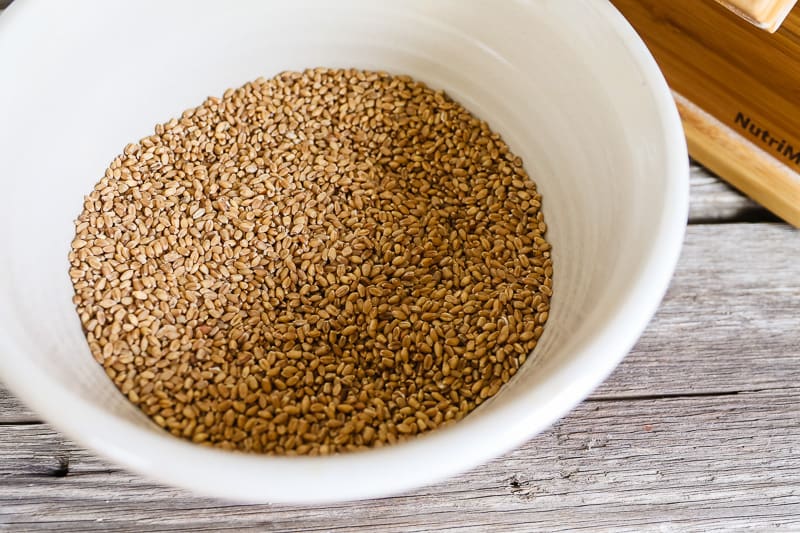
Why Bother with Wheat Berries?
1. Wheat Berries have a Long Shelf Life.
If stored properly (see below for more tips on storage), wheat berries can last for decades in storage. While ground flour loses nutrients and shelf life relatively quickly, like other whole nuts or seeds, wheat berries will stay fresh in their whole-form for a looooong time.
As I mentioned in my podcast episode about wheat berries that I had a long-forgotten bucket of wheat berries in a corner of our basement. They were still fresh and viable, even though I had ignored them for years, which was super handy when the flour shortage hit.
2. Wheat Berries are Versatile.
Beyond grinding wheat berries to make your own flour, you can also use them like you would many other grains. You can make oatmeal or porridge with them for breakfast. You can use them as an alternative to rice as a side dish; you can pop them like popcorn; and you can even make sprouts with them (check out my Guide to Growing Sprouts for instructions) for a crunchy and nutritious topping to your salads and sandwiches.
Whole wheat can also be used to feed your livestock by making fodder (I was originally going to feed my wheat berries to the chickens, but with the recent flour shortage, I was super happy that I still had them available to make flour instead).
3. Wheat Berries are Good for You.
Since wheat berries are not processed, they retain their nutritional value much better than ground flour from the store. Wheat berries are an excellent source of fiber, protein, iron, several vitamins, and minerals. And when you grind the wheat berries for immediate use as flour, that flour contains more nutrients than store-bought ground flour since it’s so fresh and has not had any edible parts removed. You can learn more about the health benefits of whole wheat in this article.
Types of Wheat Berries
There are a few different types of wheat berries and it can be a bit confusing when you see all the names and descriptions. The different names are based on a few factors: the color (red or white), the growing season for the wheat berries (winter or spring), and the gluten content (hard or soft).
Hard vs. Soft
Hard varieties generally contain more protein and gluten, while soft varieties usually contain more starch. Soft wheat berries are usually used for pastries and cakes while hard wheat berries are more often used in bread. Hard wheat berries often need a bit of extra time to cook into porridges and other such meals as well.
The good news though is that hard/soft wheat berries can almost always be used interchangeably, but it’s still nice to understand the differences.
P.S. Hard and soft wheat looks and feels practically the same when you look at it in berry-form– you won’t be able to tell the difference unless you have a trained eye.
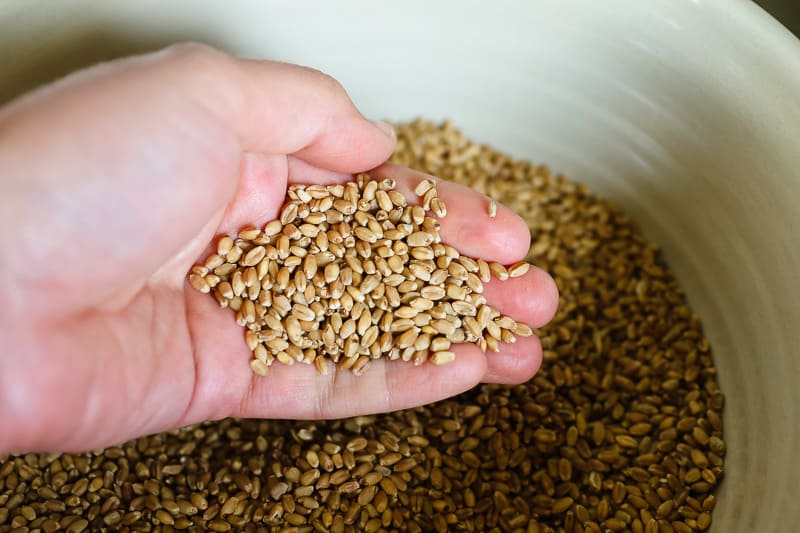
Red vs. White
1. Red Wheat Berries
Red wheat berries are darker in color than white wheat berries and are used to make whole wheat flour (not to be confused with whole white wheat flour, which comes from white berries). They have a slightly higher protein content and is best used in hearty and heavy bread recipes. People who try to make whole wheat breads with 100% red wheat can sometimes be disappointed because the loaves usually turn out darker and denser.
Hard red wheat berries (both winter and spring varieties) are the classic wheat used in many yeast breads. They can be more difficult to digest due to their heavy nature and since they are hard, they have a higher gluten content.
2. White Wheat Berries
White wheat berries are used to make whole white wheat flour. They are also slightly lighter in color than red wheat berries. White wheat berries are a good place for bread-making newbies to start, you’ll tend to get a lighter bread with white berries compared to red. However, keep in mind that white wheat flour is still whole wheat— it will not be as fluffy as all-purpose flour, which has been processed and sifted.
Hard white wheat berries are great for making all-purpose white wheat flour and works great for yeast bread recipes. It is also what is most often used in home beer-brewing.
Soft white wheat berries are the lightest colored wheat berries. They are most often used to make pastry flour and are best used in pie crusts, pastries, and cookies.
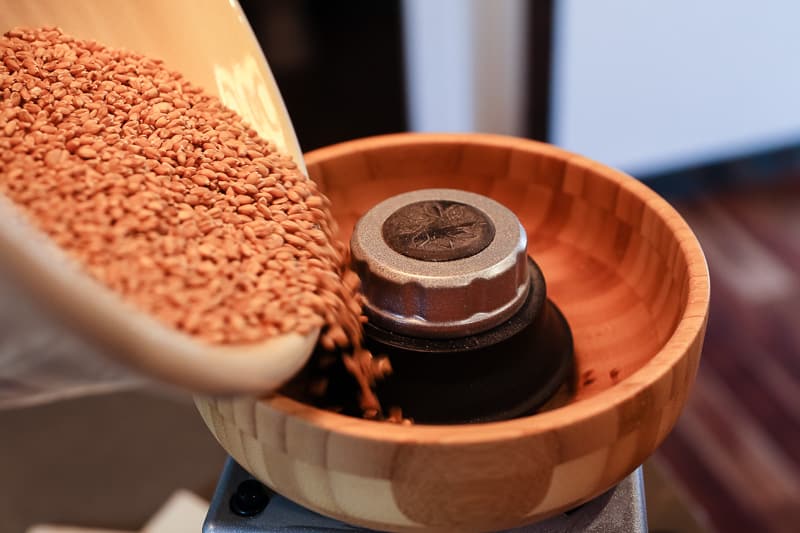
How Can Wheat Berries Be Used for Cooking?
I mainly use my wheat berries to grind into fresh flour (check the next section below for details on that).
But wheat berries have plenty of other uses, too. Basically, you can use them however you might use rice or other whole grains.
Here are the basics to cooking with wheat berries:
Cooking Wheat Berries:
This is similar to how you cook rice, quinoa, or other grains. Rinse 1 cup of raw wheat berries in a colander in the sink. Bring 2.5 cups water to a boil, add 1 cup of raw wheat berries. Reduce the heat, cover and simmer for 1 hour (or until wheat berries are tender). Drain and fluff with a fork. This will make approximately 2.5 cups of cooked wheat berries.
Just like with rice or other grains, you can also use your pressure cooker or crockpot to cook wheat berries and save time in the kitchen.
Toasting Wheat Berries:
This is optional, but it can help bring out the nutty flavors of the whole grains. Preheat the oven to 375°F. Spread the wheat berries on a baking sheet and toast in the oven for about 10 minutes, or until lightly colored.
You can also easily store cooked wheat berries in the refrigerator. If not using them right away, store the cooked wheat berries in a tightly covered container in the refrigerator for up to a week. Gently reheat in a frying pan over low heat until hot, or serve at room temperature.
Here are a few basic recipes/ideas for using wheat berries:
Breakfast Porridge:
Make cooked wheat berries and add your favorite porridge flavors, such as milk, diced apples, cinnamon, and honey.
Breakfast Parfait:
Top yogurt (homemade yogurt is amazing!) with layers of fruit, nuts, and cooled cooked wheat berries.
Soups:
Use cooked wheat berries in place of rice or lentils in your favorite soup recipes.
Salads:
Add texture and extra protein to your salads with a scoopful of warm or cold cooked wheat berries.
Dinners:
You can add the cooked wheat berries to stuffed peppers, as a side (like you would use rice) with stir-fries, in taco recipes as a topping, and more.
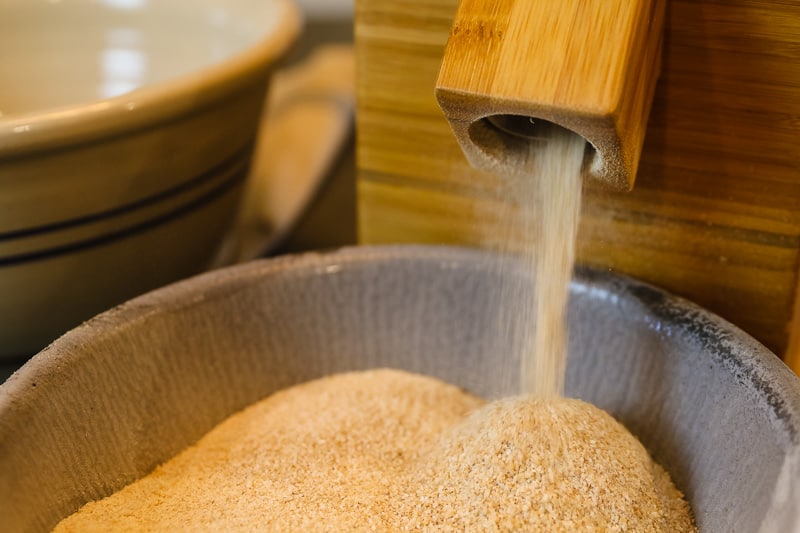
How to Grind Your Own Flour
Freshly-ground whole wheat flour contains more nutrients than whole wheat flours you’ll find at the grocery store since grinding up whole nuts/seeds/grains causes them to lose their quality quickly.
HOWEVER, freshly ground flour does have a few learning curves. For example, depending on the wheat berries you have, it can produce a denser, heavier bread if you don’t know what you’re doing.
If you’ve only ever baked with all-purpose flour, a quick switch to 100% whole wheat can be quite the shock (and leave you with loaves that double as bricks.)
When you grind the wheat berries, the resulting flour is full of air from shooting out of the grinder so measuring freshly ground wheat can also be a bit tricky. Try letting the flour settle for about 30 minutes to let it settle before using it.
It’s best to only grind wheat berries right before you plan to use the flour, as freshly ground wheat berries can go rancid very quickly. Store-bought flours are usually treated or processed in a way to prevent the oils in wheat from turning rancid after grinding so they can be shelf-stable.
Therefore, as tempting as it may be, I don’t suggest grinding 30 pounds of wheat flour to use for later. (One exception to this is if you have room in your freezer to store the fresh flour– freezing helps to slow down the oxidation process.)
It’s wise to only grind enough wheat berries for what you need in your current recipe or for the baking you plant to do that week. If you do want to grind a little extra, store the freshly-ground flour in the freezer or refrigerator.
How many wheat berries equals one cup of flour?
It’s hard to make a completely accurate ratio, since it depends on the how finely you grind your wheat berries and there will also be extra air in the freshly-ground flour. However, a good rule of thumb is that 1 cup of wheat berries will produce slightly less than 2 cups of flour.
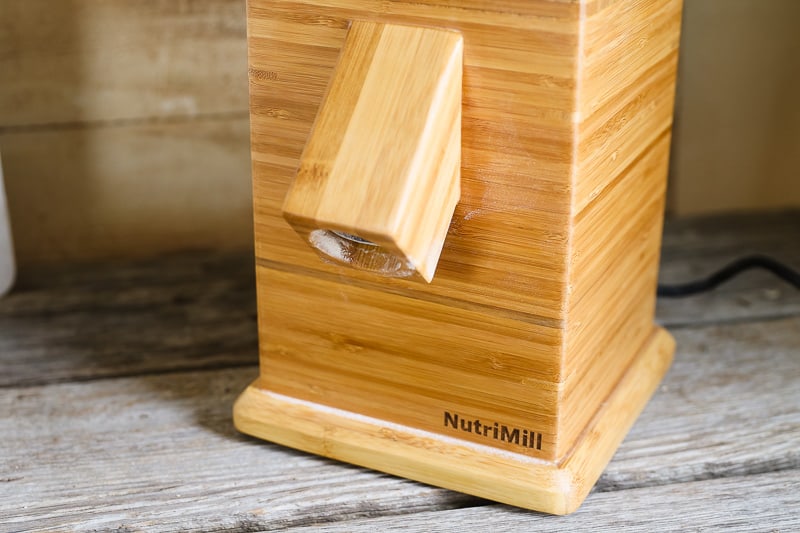
Choosing a Grain Mill for Grinding Wheat Berries
There are plenty of different types of grain mills on the market. Some are stand-alone appliances while others are attachments for your mixer or attach to your counter. There are also vintage hand-cranked ones and electric ones.
It really depends on what works best for you and your kitchen. For example, I started with a huge grain mill that couldn’t fit in my kitchen cupboards before purchasing this smaller Nutri-Mill grain mill that fits better in my kitchen (both stylistically and size).
Lehman’s, my favorite online store for kitchen supplies, has a bunch of grain mill options, varying from hand-cranked to electric on their website.
Keep these things in mind while making your grain mill purchase:
- Do you have to feed a large family? If so, you might need a larger grain mill so you can make multiple bread loaves at a time. Otherwise, a smaller one like I have can work great.
- What type of space do you have for grain mill in your kitchen? You might only have space for an attachment for your Kitchen-Aid mixer instead of a stand-alone grain mill.
- Do you love decorating your kitchen with vintage-looking kitchen pieces? If you like to decorate with your kitchen appliances and/or you have a LOT of patience, you might want a hand-cranking grain mill.
What Other Grains Can Be Ground into Flour with a Grain Mill?
Grain mills can also grind rye, corn, rice, barley, oats, buckwheat, millet, quinoa, lentils, dried beans, seeds, and nuts.
You can even grind popcorn in your grain mill to use as an alternative for corn meal (which I spread on the bottom of my Dutch Oven when I’m making homemade sourdough bread).
Where to Buy Wheat Berries
Eh, it’s normally pretty easy to buy wheat berries, but a lot of locations are sold out right now. However, sometimes you can find wheat berries at normal grocery stores and apparently, even Walmart carries wheat berries from time to time (this probably depends where you live).
Otherwise, check your local natural food store or try to contact a local organic mill (check out my tips here for finding local food sources).
If you can’t find them at local stores, you can also purchase them online. Azure Standard is an online option for many parts of the United States, and they often carry wheat berries. You can also find wheat berries at True Leaf Market and I found some Hard Red Winter Wheat Berries at Lehman’s store.
We have a local organic wheat farmer in our area, and I will be making my future purchases from them.
Don’t want to grind your own wheat, but yet still want to feed your family wholesome flour? There are many great sources for purchasing organic, unbleached flour, both online and most likely local to your area as well.
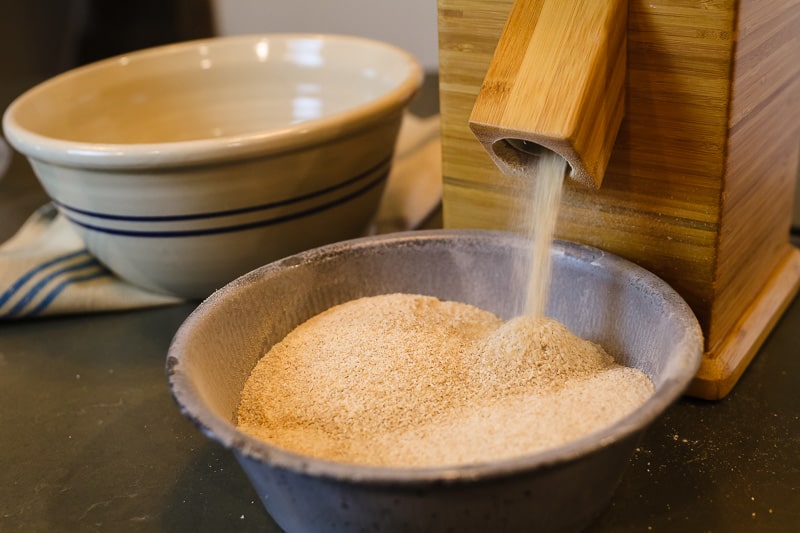
How to Store Wheat Berries
As long as you store wheat berries properly, they can stay fresh for at least a year or longer.
Store wheat berries in a cool, dry place in an air-tight container with a well-fitting lid.
I store mine in food-grade 5-gallon buckets in our basement, and keep a smaller jar upstairs that I refresh when needed. Something like these would work well.
Cooked wheat berries store very well in the freezer, so you can prepare them in advance so you have quick meals ready as needed. Simply cook them like normal (instructions in an above section), then let them cool completely. Store them in your freezer in a freezer-safe container for 3 months (or a little longer if you like).
All in all, I think a generous supply of whole wheat and a grain mill is a fantastic addition to any everyday preparedness pantry. It’s one of the best ways to protect yourself from future flour shortages, and only expands your homestead skill repertoire.
Happy milling, friends!
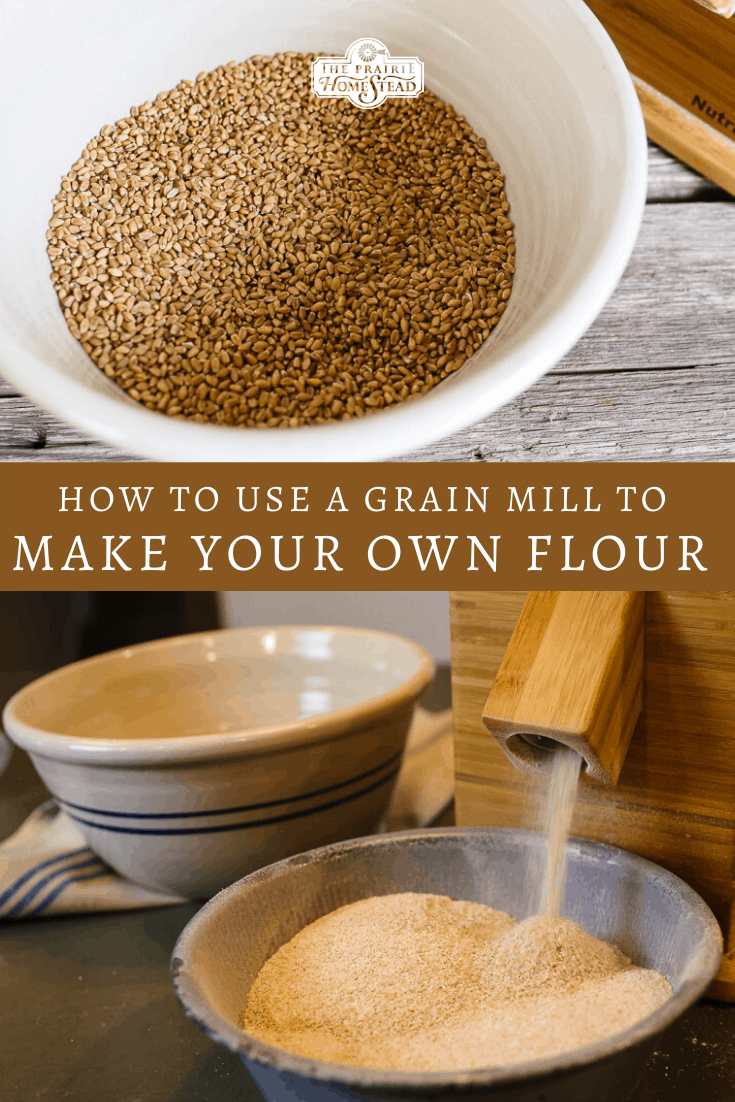
More From-Scratch & Heritage Food Tips:
- My Heritage Cooking Crash Course will help teach you how to make from-scratch recipes without spending hours in the kitchen
- Troubleshooting Sourdough (your questions answered on sourdough troubles)
- My super easy & versatile Bread Dough Recipe (for bread, pizza, cinnamon rolls, and more)
- The Ultimate Guide to Canning Safety
- How to Use a Fermenting Crock
Listen to the Old Fashioned On Purpose podcast episode #107 all about grain mills, flour shortages, and whole wheat:
The post How to Use a Grain Mill to Make Your Own Flour from Wheat Berries appeared first on The Prairie Homestead.
Via Gardening http://www.rssmix.com/
No comments:
Post a Comment